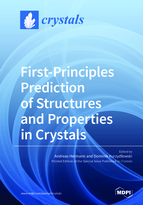First-Principles Prediction of Structures and Properties in Crystals
A special issue of Crystals (ISSN 2073-4352). This special issue belongs to the section "Inorganic Crystalline Materials".
Deadline for manuscript submissions: closed (30 June 2019) | Viewed by 34150
Special Issue Editors
Interests: condensed matter physics; chemical physics; density functional theory; crystal structure prediction; extreme conditions science
Special Issue Information
Dear Colleagues,
The prediction of the crystal structures and properties of compounds purely from electronic structure calculations, without input from experimental data, has become a large research area spanning physics, chemistry, geosciences, and materials science. Its success relies on electronic structure methods (most often density functional theory) that can accurately map the crystalline configurational space of a given compound, together with the development of efficient survey algorithms of said space, for instance through evolutionary or genetic algorithms, particle swarm optimisation techniques, high-throughput screening, and others. In addition to finding energetically most stable structures, recent software developments also allow targeted searches for desirable properties, such as specific electronic band gaps or mechanical hardness.
Crystal structure prediction has seen its biggest successes in areas where the chemical space is too large to explore exhaustively through synthesis; where experiments are limited and difficult (e.g., under extreme conditions); and, generally, where chemical intuition and other approaches to rationalise structural choices fail. It therefore complements experiments not only in an explanatory but a truly explorative manner.
This Special Issue aims at taking stock of the current state of the field, highlighting the capabilities (and perhaps, current shortcomings or future opportunities) of first-principles prediction methods of crystal structures and properties. Scientists across a range of disciplines are invited to contribute to this collection. The topics presented in the keywords cover broadly the scope of this Special Issue, but do not restrict it; innovative contributions are particularly welcome.
Dr. Andreas Hermann
Dr. Dominik Kurzydlowski
Guest Editors
Manuscript Submission Information
Manuscripts should be submitted online at www.mdpi.com by registering and logging in to this website. Once you are registered, click here to go to the submission form. Manuscripts can be submitted until the deadline. All submissions that pass pre-check are peer-reviewed. Accepted papers will be published continuously in the journal (as soon as accepted) and will be listed together on the special issue website. Research articles, review articles as well as short communications are invited. For planned papers, a title and short abstract (about 100 words) can be sent to the Editorial Office for announcement on this website.
Submitted manuscripts should not have been published previously, nor be under consideration for publication elsewhere (except conference proceedings papers). All manuscripts are thoroughly refereed through a single-blind peer-review process. A guide for authors and other relevant information for submission of manuscripts is available on the Instructions for Authors page. Crystals is an international peer-reviewed open access monthly journal published by MDPI.
Please visit the Instructions for Authors page before submitting a manuscript. The Article Processing Charge (APC) for publication in this open access journal is 2600 CHF (Swiss Francs). Submitted papers should be well formatted and use good English. Authors may use MDPI's English editing service prior to publication or during author revisions.
Keywords
- crystal structure prediction techniques
- high-throughput screening
- constraint sampling
- fitness functions
- materials properties
- low-dimensional materials and interfaces
- new chemistry
- extreme conditions







